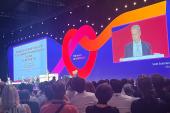New Dapagliflozin Insights: Early Benefits and Types of Deaths Prevented
New analyses help flesh out the expected mortality impact of SGLT2 inhibitors, and how swiftly the drugs take effect.

Additional analyses of recent dapagliflozin trials should help clinicians understand the best ways to implement them in practice, as well as their expected benefits, researchers said at the recent Heart Failure Society of America (HFSA) 2022 meeting in Washington, DC.
In one presentation, Akshay Desai, MD (Brigham and Women’s Hospital, Boston, MA), showed that the lower rates of cardiovascular mortality in dapagliflozin-treated patients with heart failure and either reduced or preserved ejection fraction (HFrEF and HFpEF, respectively) in the DAPA-HF and DELIVER trials were driven primarily by reduced risks of sudden death and deaths due to worsening heart failure, but not deaths due to stroke or MI. There was no effect on noncardiovascular mortality.
In another, looking at the timing of SGLT2 inhibitor effects in DELIVER, Muthiah Vaduganathan, MD (Brigham and Women’s Hospital), reported that dapagliflozin (Farxiga; AstraZeneca) provided a significant reduction in the primary composite endpoint of CV death or worsening heart failure as early as 13 days after treatment initiation, with significant benefits sustained through the end of the study.
These two studies, which were published simultaneously online in JAMA Cardiology, along with others presented at the HFSA meeting, “really drive home the point that treatment with SGLT2 inhibitors, and dapagliflozin in particular, is really part of foundational therapy for heart failure patients across the spectrum of ejection fraction due to the potent effects on clinical outcomes that are of importance to patients, including heart failure hospitalization and cardiovascular death,” Desai told TCTMD.
“I think that the urgency to get these drugs on board for patients is now plain really regardless of their ejection fraction at the time of presentation,” he continued. “The message is really quite simple, that if you have symptomatic heart failure, whatever your ejection fraction, in the absence of a contraindication you really should be initiated on an SGLT2 inhibitor.”
Combining DAPA-HF and DELIVER
In both DAPA-HF, which included patients with LVEF ≤ 40%, and DELIVER, which included patients with LVEF > 40%, dapagliflozin 10 mg once daily reduced the primary composite endpoint of CV death or worsening heart failure by a relative 26% and 18%, respectively, versus placebo. But neither trial, Desai said, was individually designed to assess effects on overall mortality or key secondary outcomes.
Investigators prespecified a pooled analysis of both trial populations to provide better estimates of treatment effects across a range of outcomes. The main results, with a total of 11,007 patients, were reported earlier this year showing that dapagliflozin reduced the risk of CV death (HR 0.86; 95% CI 0.76-0.97), all-cause death (HR 0.90; 95% CI 0.82-0.99), total HF hospitalizations (RR 0.71; 95% CI 0.65-0.78), and other outcomes.
In the current analysis, investigators dug deeper into cause-specific mortality, as adjudicated by a blinded clinical events committee. Overall, 29.9% of deaths were noncardiovascular, 16.5% had an undetermined cause, and the rest had cardiovascular causes, including sudden death (27.1%), heart failure (17.8%), stroke (4.2%), MI (2.9%), and other (1.6%).
Compared with patients who died of CV causes, the patients with noncardiovascular deaths tended to be older with less-severe heart failure and had a lower rate of prior HF hospitalization, a lower baseline level of NT-proBNP, and higher ejection fraction.
Overall, mortality was greater at the lower end of the LVEF range, primarily due to higher rates of CV death. Noncardiovascular deaths occurred at relatively consistent rates across the LVEF spectrum, but they accounted for a greater proportion of overall deaths at the higher end of the range because of fewer CV deaths in those groups.
“This may be one of the reasons it’s been harder in clinical trials to show a treatment effect that influences rates of cardiovascular death or overall mortality in the preserved EF population because so many of those patients die from noncardiovascular causes and those are less likely to be influenced by cardiovascular therapies,” Desai said.
Looking at dapagliflozin’s impact on cause-specific mortality, the reduction in CV mortality was mostly related to lower rates of HF death (1.3% vs 1.5%; HR 0.88; 95% CI 0.70-1.11) and sudden death (1.9% vs 2.3%; HR 0.84; 95% CI 0.70-1.01), with no discernible differences in mortality related to stroke (0.3% in each trial arm) or MI (0.2% in each arm).
In addition, SGLT2 inhibition didn’t reduced rates of noncardiovascular death (2.4% vs 2.3%) or death from an unknown cause (1.2% vs 1.4%).
The findings were consistent regardless of baseline LVEF, which ranged from 16% to 74% (mean 44%) for patients in the pooled analysis. “These data would really support the value of use of SGLT2 inhibitors in patients with chronic heart failure regardless of ejection fraction,” Desai said.
Benefits Take Hold Early On
For the analysis presented by Vaduganathan, investigators examined when a significant benefit of dapagliflozin first emerged during follow-up in the DELIVER trial. SGLT2 inhibition, he noted, appears to influence key biological pathways leading to rapid effects on diuresis and hemodynamics.
For the primary endpoint of CV death or worsening heart failure, a significantly lower risk with dapagliflozin versus placebo was first observed on day 13 of follow-up (HR 0.45; 95% CI 0.20-0.99), with significance maintained from day 15 through the end of the study.
You don’t really care what the ejection fraction is when you’re thinking about an SGLT2 inhibitor. Jane Wilcox
Similarly, the risk of worsening HF events first significantly favored dapagliflozin at day 16 (HR 0.45; 95% CI 0.21-0.96), with durable benefits throughout follow-up.
The advantage for SGLT2 inhibition was most apparent early on, something that was also seen in the EMPEROR-Preserved trial of empagliflozin (Jardiance, Boehringer Ingelheim/Eli Lilly), Vaduganathan pointed out.
“We believe these data really underscore the rapid clinical benefits observed with the SGLT2 inhibitor dapagliflozin and highlight opportunities for early identification of the disease and prompt management of this patient population without delay,” he said.
Act Fast
Commenting for TCTMD, Jane Wilcox, MD (Bluhm Cardiovascular Institute, Northwestern University, Chicago, IL), one of the moderators of the HFSA session at which the results were discussed, agreed with the need to consider SGLT2 inhibition right away.
“If you see a patient who has HFpEF, you need to be having that conversation in clinic that day,” she said. “It can’t really wait until the next visit, which may be 3 months from now, because you’ve missed an opportunity to prevent worsening heart failure in that patient.”
This is especially important for patients with HFpEF, who haven’t had any proven treatments prior to the emergence of the SGLT2 inhibitors, but in a broader sense, these discussions should be taking place for patients with HF regardless of LVEF, Wilcox indicated.
“You don’t really care what the ejection fraction is when you’re thinking about an SGLT2 inhibitor,” she said. “You’re thinking just: do you have the clinical syndrome of heart failure? And if so, then an SGLT2 inhibitor would be indicated.”
Though these drugs aren’t for everyone—they’re not indicated in patients with type 1 diabetes, for instance—and they do increase the risk for certain side effects, like genital mycotic infections, they are well tolerated, Wilcox said, adding that a positive aspect of the SGLT2 inhibitors is that they don’t need to be titrated.
Now, efforts are needed “really just trying to increase awareness to get the therapies in the hands of the patients,” she said, acknowledging that there are always concerns about access and affordability with new drugs. That appears to be the case with the SGLT2 inhibitors as well. “Payers need to be working with healthcare systems, and we need to be working with the pharmaceutical companies to make these drugs affordable for our patients,” Wilcox said.
Todd Neale is the Associate News Editor for TCTMD and a Senior Medical Journalist. He got his start in journalism at …
Read Full BioSources
Desai AS, Jhund PS, Claggett BL, et al. Effect of dapagliflozin on cause-specific mortality in patients with heart failure across the spectrum of ejection fraction: a participant-level pooled analysis of DAPA-HF and DELIVER. JAMA Cardiol. 2022;Epub ahead of print.
Vaduganathan M, Claggett BL, Jhund P, et al. Time to clinical benefit of dapagliflozin in patients with heart failure with mildly reduced or preserved ejection fraction: a prespecified secondary analysis of the DELIVER randomized clinical trial. JAMA Cardiol. 2022;Epub ahead of print.
Disclosures
- The DAPA-HF and DELIVER trials were funded by AstraZeneca.
- The pooled analysis was supported by a grant from the British Heart Foundation Centre of Research Excellence and the Vera Melrose Heart Failure Research Fund.
- Desai reports having received grants from AstraZeneca, Abbott, Alnylam, Bayer, and Novartis; consulting fees from AstraZeneca, Abbott, Alnylam, Amgen, Bayer, Biofourmis, Cytokinetics, GlaxoSmithKline, Medpace, Merck, Novartis, Parexel, Roche, Regeneron, Verily, Axon Therapeutics, Avidity, and New Amsterdam; and fees for participating on a data safety monitoring board for Boston Scientific.
- Vaduganathan reports having received personal fees from Amgen, AstraZeneca, Baxter HealthCare, Bayer, Boehringer Ingelheim, Cytokinetics, Relypsa, American Regent, Novartis, Roche Diagnostics, Lexicon Pharmaceuticals, Galmed, Occlutech, Impulse Dynamics, Pharmacosmos, Sanofi, and Tricog Health.
- Wilcox reports consulting for AstraZeneca and Boehringer Ingelheim.





Comments